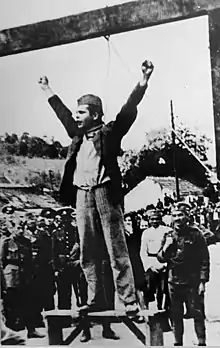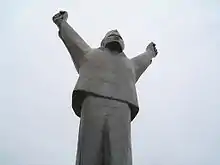Stjepan Filipović
Stjepan Filipović (27 January 1916 – 22 May 1942) was a Yugoslav communist who led the Kolubara Company of the Valjevo Partisan Detachment during the 1941 Partisan uprising.[1][2] He was captured and executed in 1942 in Valjevo. A photo of him taken shortly before his execution became a symbol of resistance against fascism in the Second World War, and was, among others, exhibited in the United Nations building in New York.[3] He was proclaimed People's Hero of Yugoslavia in 1949.
Stjepan Filipović | |
|---|---|
 | |
| Born | 27 January 1916 |
| Died | 22 May 1942 (aged 26) |
| Nationality | Yugoslav |
Biography

Stjepan Filipović was born on 27 January 1916 in Opuzen (modern-day Croatia) as the fifth child of Anton and Ivka Filipović. He was an ethnic Croat.[2] The Filipović family moved throughout the Kingdom of Yugoslavia, so he lived in Županja, Mostar and Kragujevac. In Kragujevac, he studied locksmithing and mastered the basics of electrical wiring, carpentry and bookbinding.[4] He joined the labour movement in 1937, but he was arrested in 1939 and sentenced to a year in prison. He joined the Communist Party of Yugoslavia in 1940.
Filipović was commander of the Partisans' Tamnavsko-Kolubarski unit in Valjevo (modern-day Serbia) by 1941. He was captured on 24 December 1941 by Chetniks unit of Kosta Pećanac[5] and hanged in Valjevo by Serbian State Guard unit[6] on 27 May 1942, aged 26. As the rope was put around his neck, Filipović raised his arms and shouted "Smrt fašizmu, sloboda narodu!" ("Death to fascism, freedom to the people!"). He urged the Yugoslav people to resist and implored them to never cease resisting. A photograph taken at this moment was widely reproduced and became a symbol of anti-fascist resistance. A statue of Filipović was cast in its likeness.[7]
Filipović was declared a National Hero of Yugoslavia on 14 December 1949.[8] The town of Valjevo has a statue dedicated to him, "Stevan Filipović". A monument was also erected in his home town of Opuzen in 1968, but was demolished in 1991.[3] His brother Šimun was shot by Germans in the Kragujevac massacre. Although he was an ethnic Croat, which could have saved him from death, he refused to say so, and he shared his fate with citizens of Kragujevac. Stjepan's second brother Nikola was killed in May 1943 as a member of the 1st Proletarian Brigade.[9]
References
- "Stjepan Filipović: everlasting symbol of anti-fascism". libcom.org.
- "Standing beneath the gallows where he will be hanged momentarily, Stjepan Filipovic, commander of the Tomnasko-Kolubarski partisan detachment, calls upon the people of Serbia to fight the "traitors of the Serbian people". - Collections Search - United States Holocaust Memorial Museum". collections.ushmm.org.
- "NAJPOZNATIJI HRVAT U UN-U Njegova slika stoji na samom ulazu, a hrvatske vlasti ga se stide". Index.hr. 23 May 2017.
- Radanović, Milan (May 21, 2012). "Stjepan Filipović: heroj radničke i antifašističke borbe: 70 godina od smrti". starosajmiste.info.
- "Стеван (Стјепан, Стипан) Филиповић". Stjepan Filipovic Elementary School.
Заробљен је 24. децембра 1941. од стране тзв. легализованих четника војводе Дамњана Тешмановића, који је припадао формацији четника Косте Пећанца (ова четничка формација je повремено била супротстављена четницима под командом Равне Горе)..."He was captured on December 24, 1941 by the so-called legalized Chetniks of Vojvoda Damnjan Tešmanović, who belonged to the Chetnik formation of Kosta Pećanac (this Chetnik formation was occasionally opposed to the Chetniks under the command of Ravna Gora).
- Deak, Istvan (2018). Europe on Trial: The Story of Collaboration, Resistance, and Retribution during World War II. Routledge. p. 159. ISBN 978-0-42997-350-5.
- Sinclair, Upton; Sagarin, Edward; Teichner, Albert (1964). The Cry for Justice: An Anthology of the Literature of Social Protest (Revised ed.). L. Stuart.
- Burns, Richard (2006). The Blue Butterfly: Selected Writings. Salt Modern Poets. p. 144. ISBN 1-84471-258-3.
- "Стеван (Стјепан, Стипан) Филиповић". Stjepan Filipovic Elementary School.
Према речима Стеванове и Шимунове сестре Јелице, Шимун је као Хрват вероватно могао да избегне колективну нацистичку одмазду, међутим он је одбио да нагласи своје етничко порекло, поделивши судбину својих суграђана. Ипак, било би неочекивано да су фашисти поштедели живот брату двојице партизанских бораца. Други Шимунов и Стеванов брат, Никола, борац Крагујевачког партизанског одреда од 1941, погинуо је маја 1943. на Зеленгори као борац Прве пролетерске бригаде..."According to Stevan's and Šimun's sister Jelica, Šimun as a Croat could probably have avoided collective Nazi retaliation, but he refused to emphasize his ethnic background, sharing the fate of his fellow citizens. However, it would be unexpected if the fascists spared the life of the brother of two partisan fighters. Šimun's and Stevan's other brother, Nikola, a fighter of the Kragujevac partisan detachment since 1941, was killed in May 1943 on Zelengora as a fighter of the First Proletarian Brigade.
External links
| Wikimedia Commons has media related to Stjepan Filipović. |
- Narodni heroji Jugoslavije, Mladost, Belgrade, 1975.